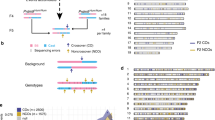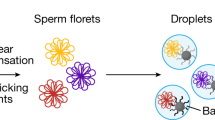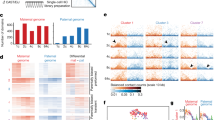Abstract
Crossover recombination reshuffles genes and prevents errors in segregation that lead to extra or missing chromosomes (aneuploidy) in human eggs, a major cause of pregnancy failure and congenital disorders. Here we generate genome-wide maps of crossovers and chromosome segregation patterns by recovering all three products of single female meioses. Genotyping >4 million informative SNPs from 23 complete meioses allowed us to map 2,032 maternal and 1,342 paternal crossovers and to infer the segregation patterns of 529 chromosome pairs. We uncover a new reverse chromosome segregation pattern in which both homologs separate their sister chromatids at meiosis I; detect selection for higher recombination rates in the female germ line by the elimination of aneuploid embryos; and report chromosomal drive against non-recombinant chromatids at meiosis II. Collectively, our findings show that recombination not only affects homolog segregation at meiosis I but also the fate of sister chromatids at meiosis II.
This is a preview of subscription content, access via your institution
Access options
Subscribe to this journal
Receive 12 print issues and online access
$209.00 per year
only $17.42 per issue
Buy this article
- Purchase on Springer Link
- Instant access to full article PDF
Prices may be subject to local taxes which are calculated during checkout





Similar content being viewed by others
References
Nagaoka, S.I., Hassold, T.J. & Hunt, P.A. Human aneuploidy: mechanisms and new insights into an age-old problem. Nat. Rev. Genet. 13, 493–504 (2012).
Hassold, T. & Hunt, P. To err (meiotically) is human: the genesis of human aneuploidy. Nat. Rev. Genet. 2, 280–291 (2001).
Zaragoza, M.V. et al. Nondisjunction of human acrocentric chromosomes: studies of 432 trisomic fetuses and liveborns. Hum. Genet. 94, 411–417 (1994).
Hassold, T.J. & Jacobs, P.A. Trisomy in man. Annu. Rev. Genet. 18, 69–97 (1984).
Hassold, T. et al. A cytogenetic study of 1000 spontaneous abortions. Ann. Hum. Genet. 44, 151–178 (1980).
Freeman, S.B. et al. The National Down Syndrome Project: design and implementation. Public Health Rep. 122, 62–72 (2007).
Koehler, K.E. et al. Spontaneous X chromosome MI and MII nondisjunction events in Drosophila melanogaster oocytes have different recombinational histories. Nat. Genet. 14, 406–414 (1996).
Rockmill, B., Voelkel-Meiman, K. & Roeder, G.S. Centromere-proximal crossovers are associated with precocious separation of sister chromatids during meiosis in Saccharomyces cerevisiae. Genetics 174, 1745–1754 (2006).
Hultén, M.A., Patel, S., Jonasson, J. & Iwarsson, E. On the origin of the maternal age effect in trisomy 21 Down syndrome: the oocyte mosaicism selection model. Reproduction 139, 1–9 (2010).
Hou, Y. et al. Genome analyses of single human oocytes. Cell 155, 1492–1506 (2013).
Handyside, A.H. et al. Karyomapping: a universal method for genome wide analysis of genetic disease based on mapping crossovers between parental haplotypes. J. Med. Genet. 47, 651–658 (2010).
Natesan, S.A. et al. Genome-wide karyomapping accurately identifies the inheritance of single-gene defects in human preimplantation embryos in vitro. Genet. Med. 16, 838–845 (2014).
Alfarawati, S. et al. The relationship between blastocyst morphology, chromosomal abnormality, and embryo gender. Fertil. Steril. 95, 520–524 (2011).
Kuliev, A., Zlatopolsky, Z., Kirillova, I., Spivakova, J. & Cieslak Janzen, J. Meiosis errors in over 20,000 oocytes studied in the practice of preimplantation aneuploidy testing. Reprod. Biomed. Online 22, 2–8 (2011).
Gutiérrez-Mateo, C. et al. Validation of microarray comparative genomic hybridization for comprehensive chromosome analysis of embryos. Fertil. Steril. 95, 953–958 (2011).
Capalbo, A. et al. Sequential comprehensive chromosome analysis on polar bodies, blastomeres and trophoblast: insights into female meiotic errors and chromosomal segregation in the preimplantation window of embryo development. Hum. Reprod. 28, 509–518 (2013).
Franasiak, J.M. et al. The nature of aneuploidy with increasing age of the female partner: a review of 15,169 consecutive trophectoderm biopsies evaluated with comprehensive chromosomal screening. Fertil. Steril. 101, 656–663 (2014).
Reiger, R., Michaelis, A. & Green, M.M. Glossary of Genetics and Cytogenetics (Springer Verlag, 1968).
Angell, R.R. Predivision in human oocytes at meiosis I: a mechanism for trisomy formation in man. Hum. Genet. 86, 383–387 (1991).
Handyside, A.H. et al. Multiple meiotic errors caused by predivision of chromatids in women of advanced maternal age undergoing in vitro fertilisation. Eur. J. Hum. Genet. 20, 742–747 (2012).
Heckmann, S. et al. Alternative meiotic chromatid segregation in the holocentric plant Luzula elegans. Nat. Commun. 5, 4979 (2014).
Cabral, G., Marques, A., Schubert, V., Pedrosa-Harand, A. & Schlogelhofer, P. Chiasmatic and achiasmatic inverted meiosis of plants with holocentric chromosomes. Nat. Commun. 5, 5070 (2014).
Viera, A., Page, J. & Rufas, J.S. Inverted meiosis: the true bugs as a model to study. Genome Dyn. 5, 137–156 (2009).
Coop, G., Wen, X., Ober, C., Pritchard, J.K. & Przeworski, M. High-resolution mapping of crossovers reveals extensive variation in fine-scale recombination patterns among humans. Science 319, 1395–1398 (2008).
Middlebrooks, C.D. et al. Evidence for dysregulation of genome-wide recombination in oocytes with nondisjoined chromosomes 21. Hum. Mol. Genet. 23, 408–417 (2014).
Kong, A. et al. A high-resolution recombination map of the human genome. Nat. Genet. 31, 241–247 (2002).
Lenzi, M.L. et al. Extreme heterogeneity in the molecular events leading to the establishment of chiasmata during meiosis I in human oocytes. Am. J. Hum. Genet. 76, 112–127 (2005).
Cheng, E.Y. et al. Meiotic recombination in human oocytes. PLoS Genet. 5, e1000661 (2009).
Gruhn, J.R., Rubio, C., Broman, K.W., Hunt, P.A. & Hassold, T. Cytological studies of human meiosis: sex-specific differences in recombination originate at, or prior to, establishment of double-strand breaks. PLoS ONE 8, e85075 (2013).
Broman, K.W., Murray, J.C., Sheffield, V.C., White, R.L. & Weber, J.L. Comprehensive human genetic maps: individual and sex-specific variation in recombination. Am. J. Hum. Genet. 63, 861–869 (1998).
Tease, C., Hartshorne, G.M. & Hulten, M.A. Patterns of meiotic recombination in human fetal oocytes. Am. J. Hum. Genet. 70, 1469–1479 (2002).
Kong, A. et al. Recombination rate and reproductive success in humans. Nat. Genet. 36, 1203–1206 (2004).
Myers, S., Bottolo, L., Freeman, C., McVean, G. & Donnelly, P. A fine-scale map of recombination rates and hotspots across the human genome. Science 310, 321–324 (2005).
Kong, A. et al. Sequence variants in the RNF212 gene associate with genome-wide recombination rate. Science 319, 1398–1401 (2008).
Kong, A. et al. Fine-scale recombination rate differences between sexes, populations and individuals. Nature 467, 1099–1103 (2010).
Kong, A. et al. Common and low-frequency variants associated with genome-wide recombination rate. Nat. Genet. 46, 11–16 (2014).
Chowdhury, R., Bois, P.R., Feingold, E., Sherman, S.L. & Cheung, V.G. Genetic analysis of variation in human meiotic recombination. PLoS Genet. 5, e1000648 (2009).
Capalbo, A. et al. Correlation between standard blastocyst morphology, euploidy and implantation: an observational study in two centers involving 956 screened blastocysts. Hum. Reprod. 29, 1173–1181 (2014).
LeMaire-Adkins, R. & Hunt, P.A. Nonrandom segregation of the mouse univalent X chromosome: evidence of spindle-mediated meiotic drive. Genetics 156, 775–783 (2000).
Kouznetsova, A., Lister, L., Nordenskjold, M., Herbert, M. & Hoog, C. Bi-orientation of achiasmatic chromosomes in meiosis I oocytes contributes to aneuploidy in mice. Nat. Genet. 39, 966–968 (2007).
Wolstenholme, J. & Angell, R.R. Maternal age and trisomy—a unifying mechanism of formation. Chromosoma 109, 435–438 (2000).
Garcia-Cruz, R. et al. Dynamics of cohesin proteins REC8, STAG3, SMC1β and SMC3 are consistent with a role in sister chromatid cohesion during meiosis in human oocytes. Hum. Reprod. 25, 2316–2327 (2010).
Sandler, L. & Novitski, E. Meiotic drive as an evolutionary force. Am. Nat. 91, 105–110 (1957).
Bongiorni, S., Fiorenzo, P., Pippoletti, D. & Prantera, G. Inverted meiosis and meiotic drive in mealybugs. Chromosoma 112, 331–341 (2004).
Pardo-Manuel de Villena, F. & Sapienza, C. Nonrandom segregation during meiosis: the unfairness of females. Mamm. Genome 12, 331–339 (2001).
Dawe, R.K. & Cande, W.Z. Induction of centromeric activity in maize by suppressor of meiotic drive 1. Proc. Natl. Acad. Sci. USA 93, 8512–8517 (1996).
Haig, D. & Grafen, A. Genetic scrambling as a defence against meiotic drive. J. Theor. Biol. 153, 531–558 (1991).
Chmátal, L. et al. Centromere strength provides the cell biological basis for meiotic drive and karyotype evolution in mice. Curr. Biol. 24, 2295–2300 (2014).
Brandvain, Y. & Coop, G. Scrambling eggs: meiotic drive and the evolution of female recombination rates. Genetics 190, 709–723 (2012).
Wang, T. et al. Polar body genome transfer for preventing the transmission of inherited mitochondrial diseases. Cell 157, 1591–1604 (2014).
Lynn, A. et al. Covariation of synaptonemal complex length and mammalian meiotic exchange rates. Science 296, 2222–2225 (2002).
Campbell, C.L., Furlotte, N.A., Eriksson, N., Hinds, D. & Auton, A. Escape from crossover interference increases with maternal age. Nat. Commun. 6, 6260 (2015).
Angell, R. First-meiotic-division nondisjunction in human oocytes. Am. J. Hum. Genet. 61, 23–32 (1997).
Garcia-Cruz, R. et al. Cytogenetic analyses of human oocytes provide new data on non-disjunction mechanisms and the origin of trisomy 16. Hum. Reprod. 25, 179–191 (2010).
Copsey, A. et al. Smc5/6 coordinates formation and resolution of joint molecules with chromosome morphology to ensure meiotic divisions. PLoS Genet. 9, e1004071 (2013).
Hughes, S.E. et al. Heterochromatic threads connect oscillating chromosomes during prometaphase I in Drosophila oocytes. PLoS Genet. 5, e1000348 (2009).
Hughes-Schrader, S. Distance segregation and compound sex chromosomes in mantispids (Neuroptera:Mantispidae). Chromosoma 27, 109–129 (1969).
Kuwayama, M. Highly efficient vitrification for cryopreservation of human oocytes and embryos: the Cryotop method. Theriogenology 67, 73–80 (2007).
Kuwayama, M., Vajta, G., Kato, O. & Leibo, S.P. Highly efficient vitrification method for cryopreservation of human oocytes. Reprod. Biomed. Online 11, 300–308 (2005).
Wickham, H. ggplot2: Elegant Graphics for Data Analysis (Springer, 2009).
Acknowledgements
We gratefully acknowledge C. May, A. Eyre-Walker, J. Gruhn, R. Rowsey, J. Turner, F. Cole and members of the Hoffmann laboratory for discussion and critical reading of the manuscript. We thank Y. Hou, W. Fan and S. Xie for freely sharing data and discussion on their study of female pronucleus–PB trios. Financial support for this research was provided by the UK Medical Research Council (Senior Research Fellowship to E.R.H.; G0902043) and a European Molecular Biology Organization (EMBO) Young Investigator award to E.R.H.
Author information
Authors and Affiliations
Contributions
A.C., C.S.O., D.C., L.R., F.M.U., K.S., M.C.S. and A.R.T. were responsible for donor consenting, oocyte collection and oocyte activation. L.R., F.M.U., A.H.H. and K.S. oversaw ethical and legal regulation in Italy and the UK. A.C., C.S.O., S.A.N., H.A.J. and D.C. carried out amplification, SNP array and aCGH experiments. A.H.H., L.J.N., C.S.O. and E.R.H. analyzed the encoded data. E.R.H. and A.D.H. carried out data analysis and simulations. E.R.H. and E.H. carried out statistical analyses. E.R.H., A.H.H. and L.J.N. generated the figures. E.R.H., A.H.H., L.J.N. and C.S.O. wrote the manuscript. A.H.H., C.S.O., D.K.G., A.C., L.J.N. and E.R.H. edited the manuscript. All authors proofread and accepted the manuscript.
Corresponding authors
Ethics declarations
Competing interests
The authors declare no competing financial interests.
Integrated supplementary information
Supplementary Figure 1 Phasing of maternal haplotypes.
Informative SNPs are phased using the assumed ancestor method10. A haploid cell containing a single chromatid (1C; either PB2 or Egg) is chosen as the ‘assumed ancestor’, also known as the reference. Trios from the same mother (or embryos from the same father) are ‘assumed offspring’. Using the reference, crossovers in all other assumed offspring are mapped where haplotypes change in comparison to the assumed ancestral phasing. Crossovers shared by sibling trios (or assumed offspring; red boxes) can be used to infer crossovers in the assumed ancestor. Iterative phasing using all available oocytes and PB2 allows deduction of the maternal haplotypes.
Supplementary Figure 2 Validation of whole-chromosome aneuploidy by aCGH.
An example of chromosome segregation abnormalities inferred from the SNP array patterns in oocyte-PB trios and confirmed by aCGH of the same amplified DNA from all three samples. In the aCGH output, the green and pink lines are the internal female samples and the blue trace indicates the male reference. The log2 ratios of the X chromosomes of the reference genomes are used for internal calibration of whole-chromosome loss or gain. The MeioMaps for three chromosomes in the same oocyte-PB trio are shown below the aCGH traces (G04_1). For chromosome 13, three chromatids segregated to the first polar body, and a single chromatid was present in the second polar body and missing in the oocyte. This is consistent with precocious separation of sister chromatids (PSSC) at meiosis I. Chromosome 20 segregated normally at meiosis I (normal PB1), but there was a gain in the oocyte and a corresponding loss in the PB2, consistent with meiosis II nondisjunction. Chromosome 22 underwent a partial gain in PB1 and a corresponding loss in the oocyte. This is consistent with a gross structural rearrangement whereby the majority of chromosome 22 segregated to the PB1 along with the intact homolog (Supplementary Table 4). In the SNP representations, yellow and green blocks represent the two different grandparental haplotypes and blue blocks denote regions where both haplotypes are present. All aneuploidies in the oocyte-PB trio data set were verified using aCGH. Validation for embryos has been published previously12.
Supplementary Figure 3 Non-canonical segregation patterns.
(a) Meiosis I nondisjunction yields a PB1 containing all four chromatids and an empty oocyte and PB2 (top) or an empty first polar body and two non-sister chromatids in the oocyte and PB2 (bottom). (b) Precocious separation of sister chromatids (PSSC) has four possible segregation outcomes (i–iv). The green homolog has separated precociously at meiosis I, and the yellow homolog segregates normally either to the oocyte (top) or the PB1 (bottom). At meiosis II, the green chromatid segregates randomly to the oocyte (i) and (iii), or to the PB2 (ii) and (iv). Note that one of the nine PSSC events involved a structural change in combination with the precocious separation of the sister chromatids in meiosis I. (c) Meiosis II nondisjunction results in two sister chromatids in either the oocyte or PB2 (shown for green only). This pattern could also arise from an earlier PSSC event, where the two sister chromatids have come apart and both stay in the oocyte at meiosis I. (d) Reverse segregation. Both homologs segregate their sister chromatids at meiosis I, giving rise to an intermediate where both the oocyte and PB1 contain the correct content but two non-sister chromatids (Fig. 2e). At meiosis II, the two non-sister chromatids either segregate into the PB2 and oocyte, remain in the oocyte or both segregate to the PB2 (Fig. 2d). Dotted boxes highlight three different segregation errors that would give rise to the same pattern of maternal pericentromeric SNPs in a trisomic conception (i.e., two non-sister chromatids). Without the information from the polar bodies, these three patterns are indistinguishable.
Supplementary Figure 4 Correlation of recombination detected in the oocytes and polar bodies.
(a–c) Spearman correlation (ρ) between crossover frequencies per meiosis estimated from the oocyte-PB trio and correlated with counts in PB1 only (a), oocyte only (b) and PB2 (c). (d) Correlation of crossover events detected in the oocyte as compared to the PB2. (n = 13; 5 donors). (e) Heterogeneity in haplotype lengths in the five different oocyte-PB donors.
Supplementary Figure 5 Chromosome-specific responses to recombination rates and positions in male and female meiosis.
(a) Density curves of the normalized distance of crossovers to centromeres (CEN). Statistics: Kolmogorov-Smirnov test, two-sided. (b,c) Histograms and density curves of absolute distances of crossovers to centromeres. Statistics: Kolmogorov-Smirnov test, two-sided. (d) Chromosome-specific responses in crossover position along chromosomes in the two sexes.
Supplementary Figure 6 Crossover assurance in human female meiosis.
(a) A non-exchange or exchange-less chromosome pair (E0) (left). In normal meiosis, non-exchange chromosome pairs can be detected by a single haplotype in the PB1 and the other haplotype in the oocyte and PB2. (b) E0 chromosomes that undergo reverse segregation cannot be detected directly. This is because the informative SNPs on the two chromatids in the PB1 cannot be phased; hence, potential crossovers (far right) cannot be detected. (c) PSSC events can result in three chromatids in the PB1. Both maternal SNPs will be present and detected (blue). Since reciprocal crossovers cannot be mapped, the lack of crossovers can only be presumed. (d–g) Trios with chromosomal content consistent with presumed or putative exchange-less (E0) homologs due to reverse segregation (RS) resulting in two aneuploid cells (d), reverse segregation resulting in normal chromosomal content in all three cells (e), or precocious separation of sister chromatids (PSSC) with an aneuploid (f) or euploid (g) oocyte. (h) Modeled risk of a chromosome pair failing to receive a crossover (E0) as a function of global recombination rates, using the range of rates observed in our data sets. Crossovers were allocated randomly to chromosomes with weighted probability using chromosome length; thus, longer chromosomes receive more crossovers. Data are from 10,000 simulations (Online Methods).
Supplementary information
Supplementary Text and Figures
Supplementary Figures 1–6 and Supplementary Tables 1 and 2. (PDF 485 kb)
Supplementary Tables 3–10
Supplementary Tables 3–10. (XLSX 111 kb)
Rights and permissions
About this article
Cite this article
Ottolini, C., Newnham, L., Capalbo, A. et al. Genome-wide maps of recombination and chromosome segregation in human oocytes and embryos show selection for maternal recombination rates. Nat Genet 47, 727–735 (2015). https://doi.org/10.1038/ng.3306
Received:
Accepted:
Published:
Issue Date:
DOI: https://doi.org/10.1038/ng.3306
This article is cited by
-
Variant in the synaptonemal complex protein SYCE2 associates with pregnancy loss through effect on recombination
Nature Structural & Molecular Biology (2024)
-
Actin-driven chromosome clustering facilitates fast and complete chromosome capture in mammalian oocytes
Nature Cell Biology (2023)
-
Meiosis-specific cohesin complexes display essential and distinct roles in mitotic embryonic stem cell chromosomes
Genome Biology (2022)
-
Recombination rates in pigs differ between breeds, sexes and individuals, and are associated with the RNF212, SYCP2, PRDM7, MEI1 and MSH4 loci
Genetics Selection Evolution (2022)
-
Haploidy in somatic cells is induced by mature oocytes in mice
Communications Biology (2022)



